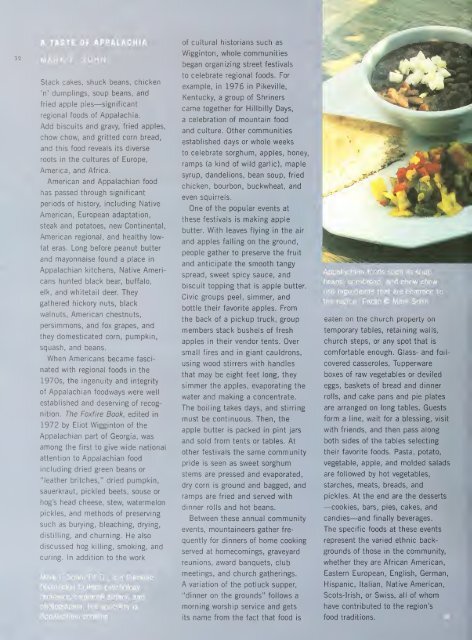SCOTLAND - Smithsonian Digital Repository - Smithsonian Institution
SCOTLAND - Smithsonian Digital Repository - Smithsonian Institution
SCOTLAND - Smithsonian Digital Repository - Smithsonian Institution
Create successful ePaper yourself
Turn your PDF publications into a flip-book with our unique Google optimized e-Paper software.
32<br />
OF APPALACHIA<br />
of cultural historians such as<br />
Wigginton, whole communities<br />
began organizing street festivals<br />
Stack cakes, shuck beans, chicken<br />
'n'<br />
dumplings, soup beans, and<br />
fried apple pies—significant<br />
regional foods of Appalachia.<br />
Add biscuits and gravy, fried apples,<br />
chow chow, and gritted corn bread,<br />
and this food reveals its diverse<br />
roots in the cultures of Europe,<br />
America, and Africa.<br />
American and Appalachian food<br />
has passed through significant<br />
periods of history, including Native<br />
American, European adaptation,<br />
steak and potatoes, new Continental,<br />
American regional, and healthy lowfat<br />
eras. Long before peanut butter<br />
and mayonnaise found a place in<br />
Appalachian kitchens. Native Americans<br />
hunted black bear, buffalo,<br />
elk,<br />
and whitetail deer. They<br />
gathered hickory nuts, black<br />
walnuts, American chestnuts,<br />
persimmons, and fox grapes, and<br />
they domesticated corn, pumpkin,<br />
squash, and beans.<br />
When Americans became fascinated<br />
with regional foods in the<br />
1970s, the ingenuity and integrity<br />
of Appalachian foodways were well<br />
established and deserving of recognition.<br />
The Foxfire Book, edited in<br />
1972 by Eliot Wigginton of the<br />
Appalachian part of Georgia, was<br />
among the first to give wide national<br />
attention to Appalachian food<br />
including dried green beans or<br />
"leather britches," dried pumpkin,<br />
sauerkraut, pickled beets, souse or<br />
hog's head cheese, stew, watermelon<br />
pickles, and methods of preserving<br />
such as burying, bleaching, drying,<br />
distilling, and churning. He also<br />
discussed hog killing, smoking, and<br />
curing. In addition to the work<br />
MaffK t: Sohft, Ph.D.', fs^ a'Pikeville<br />
(Kentucky) College psychology<br />
professor, cookbook author, and<br />
photographer. His specialty is<br />
to celebrate regional foods. For<br />
example, in 1976 in Pikeville,<br />
Kentucky, a group of Shriners<br />
came together for Hillbilly Days,<br />
a celebration of mountain food<br />
and culture. Other communities<br />
established days or whole weeks<br />
to celebrate sorghum, apples, honey,<br />
ramps (a kind of wild garlic), maple<br />
syrup, dandelions, bean soup, fried<br />
chicken, bourbon, buckwheat, and<br />
even squirrels.<br />
One of the popular events at<br />
these festivals is making apple<br />
butter. With leaves flying in the air<br />
and apples falling on the ground,<br />
people gather to preserve the fruit<br />
and anticipate the smooth tangy<br />
spread, sweet spicy sauce, and<br />
biscuit topping that is apple butter.<br />
Civic groups peel, simmer, and<br />
bottle their favorite apples. From<br />
the back of a pickup truck, group<br />
members stack bushels of fresh<br />
apples in their vendor tents. Over<br />
small fires and in giant cauldrons,<br />
using wood stirrers with handles<br />
that may be eight feet long, they<br />
simmer the apples, evaporating the<br />
water and making a concentrate.<br />
The boiling takes days, and stirring<br />
must be continuous. Then, the<br />
apple butter is packed in pint jars<br />
and sold from tents or tables. At<br />
other festivals the same community<br />
pride is seen as sweet sorghum<br />
stems are pressed and evaporated,<br />
dry corn is ground and bagged, and<br />
ramps are fried and served with<br />
dinner rolls and hot beans.<br />
Between these annual community<br />
events, mountaineers gather frequently<br />
for dinners of home cooking<br />
served at homecomings, graveyard<br />
reunions, award banquets, club<br />
meetings, and church gatherings.<br />
A variation of the potluck supper,<br />
"dinner on the grounds" follows a<br />
morning worship service and gets<br />
use ingredients that are common to<br />
the region. Photo © Mark Sohn<br />
eaten on the church property on<br />
temporary tables, retaining walls,<br />
church steps, or any spot that is<br />
comfortable enough. Glass- and foilcovered<br />
casseroles, Tupperware<br />
boxes of raw vegetables or deviled<br />
eggs, baskets of bread and dinner<br />
rolls,<br />
and cake pans and pie plates<br />
are arranged on long tables. Guests<br />
form a line, wait for a blessing, visit<br />
with friends, and then pass along<br />
both sides of the tables selecting<br />
their favorite foods. Pasta, potato,<br />
vegetable, apple, and molded salads<br />
are followed by hot vegetables,<br />
starches, meats, breads, and<br />
pickles. At the end are the desserts<br />
—cookies, bars, pies, cakes, and<br />
candies—and finally beverages.<br />
The specific foods at these events<br />
represent the varied ethnic backgrounds<br />
of those in the community,<br />
whether they are African American,<br />
Eastern European, English, German,<br />
Hispanic, Italian, Native American,<br />
Scots-Irish, or Swiss, all<br />
of whom<br />
have contributed to the region's<br />
Appalachian cooking.<br />
its<br />
name from the fact that food is<br />
food traditions.
















